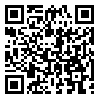Volume 12, Issue 2 (2022)
ORMR 2022, 12(2): 11-29 |
Back to browse issues page
Download citation:
BibTeX | RIS | EndNote | Medlars | ProCite | Reference Manager | RefWorks
Send citation to:



BibTeX | RIS | EndNote | Medlars | ProCite | Reference Manager | RefWorks
Send citation to:
Ebrahimi E. Understanding the main construct of calling phenomenon from the perspective of an NGO's staff: Applying A descriptive phenomenological approach. ORMR 2022; 12 (2) :11-29
URL: http://ormr.modares.ac.ir/article-28-59099-en.html
URL: http://ormr.modares.ac.ir/article-28-59099-en.html
Assistant professor, Department of management, Institute for humanities and cultural studies, Tehran, Iran. , e.ebrahimi@ihcs.ac.ir
Abstract: (2138 Views)
Purpose: Calling is a concept that has attracted the attention of researchers in various fields in the last decade. Despite that, the variety and multiplicity of definitions provided and the different formulations of this phenomenon have led to a lack of consensus on the nature and dimensions of its construct. Therefore, the present study aimed to understand the construct of calling from the perspective of employees working in a non-governmental organization to help better understand this concept.
Methodology: Since the aim was to find the structure of calling, and not to describe the experience of individuals, the research was designed and conducted with a qualitative approach of descriptive phenomenology and with the four-step Giorgi method. To collect the data, narrative interviews were conducted with eight employees of Mahak Institute, a well-known non-governmental organization in the country. To confirm the reliability of the analyzes, two methods of resonancy and reflectivity were used, which are among the evaluation methods of phenomenological research.
Results: After determining units of meaning and transformations resulting from their combination, integration and abstraction, calling was defined as a kind of transcendental muster and the center and gravity of life. In addition, the key constituents of the meaning of the phenomenon and the relationships between them showed that this concept has a double-edged nature; The positive side are the endogenous motivating dimensions and the negative side are the annoying exogenous dimensions. Finally, key constituents of the calling construct and their meaning units were analyzed based on the description of each constituent.
Methodology: Since the aim was to find the structure of calling, and not to describe the experience of individuals, the research was designed and conducted with a qualitative approach of descriptive phenomenology and with the four-step Giorgi method. To collect the data, narrative interviews were conducted with eight employees of Mahak Institute, a well-known non-governmental organization in the country. To confirm the reliability of the analyzes, two methods of resonancy and reflectivity were used, which are among the evaluation methods of phenomenological research.
Results: After determining units of meaning and transformations resulting from their combination, integration and abstraction, calling was defined as a kind of transcendental muster and the center and gravity of life. In addition, the key constituents of the meaning of the phenomenon and the relationships between them showed that this concept has a double-edged nature; The positive side are the endogenous motivating dimensions and the negative side are the annoying exogenous dimensions. Finally, key constituents of the calling construct and their meaning units were analyzed based on the description of each constituent.
Article Type: Original Research |
Subject:
Organizational Behavior and Human Resource Management
Received: 2022/01/28 | Accepted: 2022/04/11 | Published: 2022/09/26
Received: 2022/01/28 | Accepted: 2022/04/11 | Published: 2022/09/26
Send email to the article author
| Rights and permissions | |
 |
This work is licensed under a Creative Commons Attribution-NonCommercial 4.0 International License. |








